In [16]:
import folium
borders = (([-17.091, -7.443] , [122.963, 139.055]),
([-14.505, -10.005], [127.385, 134.693]),
([-13.757, -10.757], [129.557, 132.529]))
coordinates = []
for n, (lats, lons) in enumerate(borders):
x, y =[lons[0], lons[0], lons[1],lons[1]], [lats[0], lats[1], lats[1], lats[0]]
l = list(zip(x,y))
l.append(l[0])
coordinates.append(l)
geoJsonData = {
"features": [
{
"geometry": {
"coordinates": coordinates[0]
,
"type": "LineString"
},
"properties": {
"stroke": "#fc1717",
"stroke-opacity": 1,
"stroke-width": 2
},
"type": "Feature"
},
{
"geometry": {
"coordinates": coordinates[1]
,
"type": "LineString"
},
"properties": {
"stroke": "#1f1a95",
"stroke-opacity": 1,
"stroke-width": 2
},
"type": "Feature"
},
{
"geometry": {
"coordinates": coordinates[2]
,
"type": "LineString"
},
"properties": {
"stroke": "orange",
"stroke-opacity": 1,
"stroke-width": 2
},
"type": "Feature"
}
],
"type": "FeatureCollection"
}
todo = ('Climate Change due to Mountain Formation (COSMO CLM (50km)',
'Coastal Convection in the Tropics: CV based Pattern Recog.',
'SMCM: Proto-Type for Coastal Couds',
'UM: Implement sea-breeze trigger',
'Sub-km simulation of Island Storms',
'Data Analysis Software Develpment')
locations=(
(52.457739, 13.310591, 'FU Berlin', folium.Icon(color='green', prefix='fa', icon='fa-university')),
(-37.909199, 147.131103, 'Monash Uni', folium.Icon(color='blue', prefix='fa', icon='fa-university')),
(48.464822, -123.314190, 'Uni of Victoria', folium.Icon(color='orange', prefix='fas', icon='fa-handshake')),
(50.727208, -3.474619, 'UK Met Office', folium.Icon(color='black', prefix='fas', icon='fa-handshake')),
(-37.797191, 142.965023, 'Uni of Melbourne', folium.Icon(color='brown', prefix='fa', icon='fa-university')),
(53.588599, 9.829234, 'Eu XFEL', folium.Icon(color='brown', prefix='fa', icon='database')))
m = folium.Map(location=(0,0), zoom_start=2.4)
for nn, loc in enumerate(locations):
folium.Marker(loc[0:2], popup=todo[nn], tooltip=None, icon=loc[-1]).add_to(m)
#folium.GeoJson(geoJsonData,
# style_function=lambda x: {
# 'color' : x['properties']['stroke'],
# 'weight' : x['properties']['stroke-width'],
# 'opacity': 0.6,
# }).add_to(m)
display(m)
#folium.Icon?
- 10/2004 - 12/2011 : Meteorology (FU Berlin)
- 02/2012 - 03/2013 : Research Associate (FUB / DFG RiftLink)
- 05/2013 - 11/2016 : PhD (Monash Uni)
- 02/2017 - 01/2018 : Post-Doc (Monash Uni)
- 02/2018 - 12/2018 : Post-Doc (Uni Melbourne)
- 09/2018 - present : Software Engineer (Eu XFEL)
Investigation of Extremes in Island Thunderstorms¶
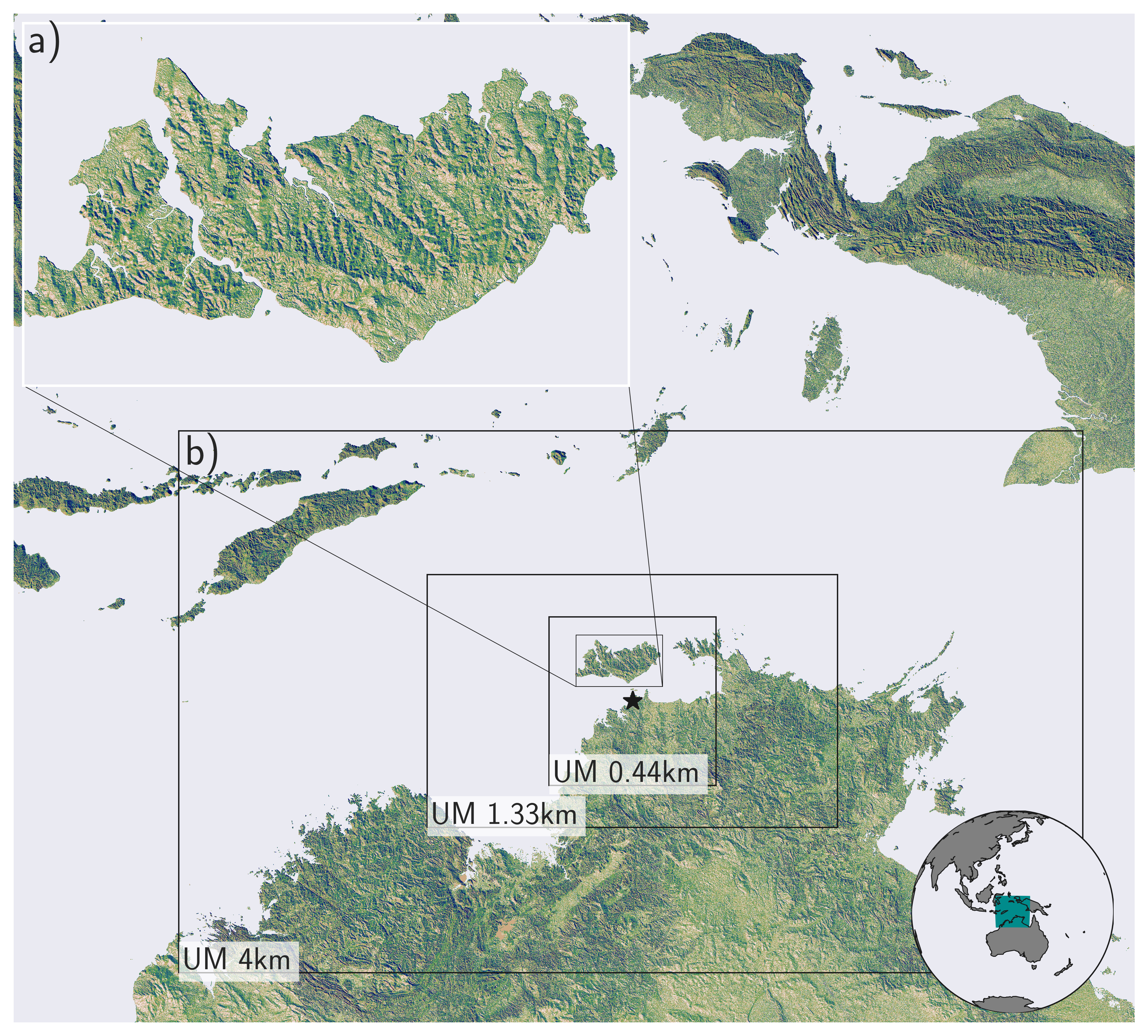
In [5]:
%%HTML
<ul>
<li>
<p><font color="#fc1717">4 km</font> → <font color='#1f1a95'>1.33 km</font>→ <font color='orange'> 0.44 km</font>
</li>
<li>80 Vertical Level</li>
<li>8 Ensemble Member, each 6 hours different init time</li>
</p>
</ul>
-
4 km → 1.33 km→ 0.44 km
- 80 Vertical Level
- 8 Ensemble Member, each 6 hours different init time
In [7]:
display(p3plot)
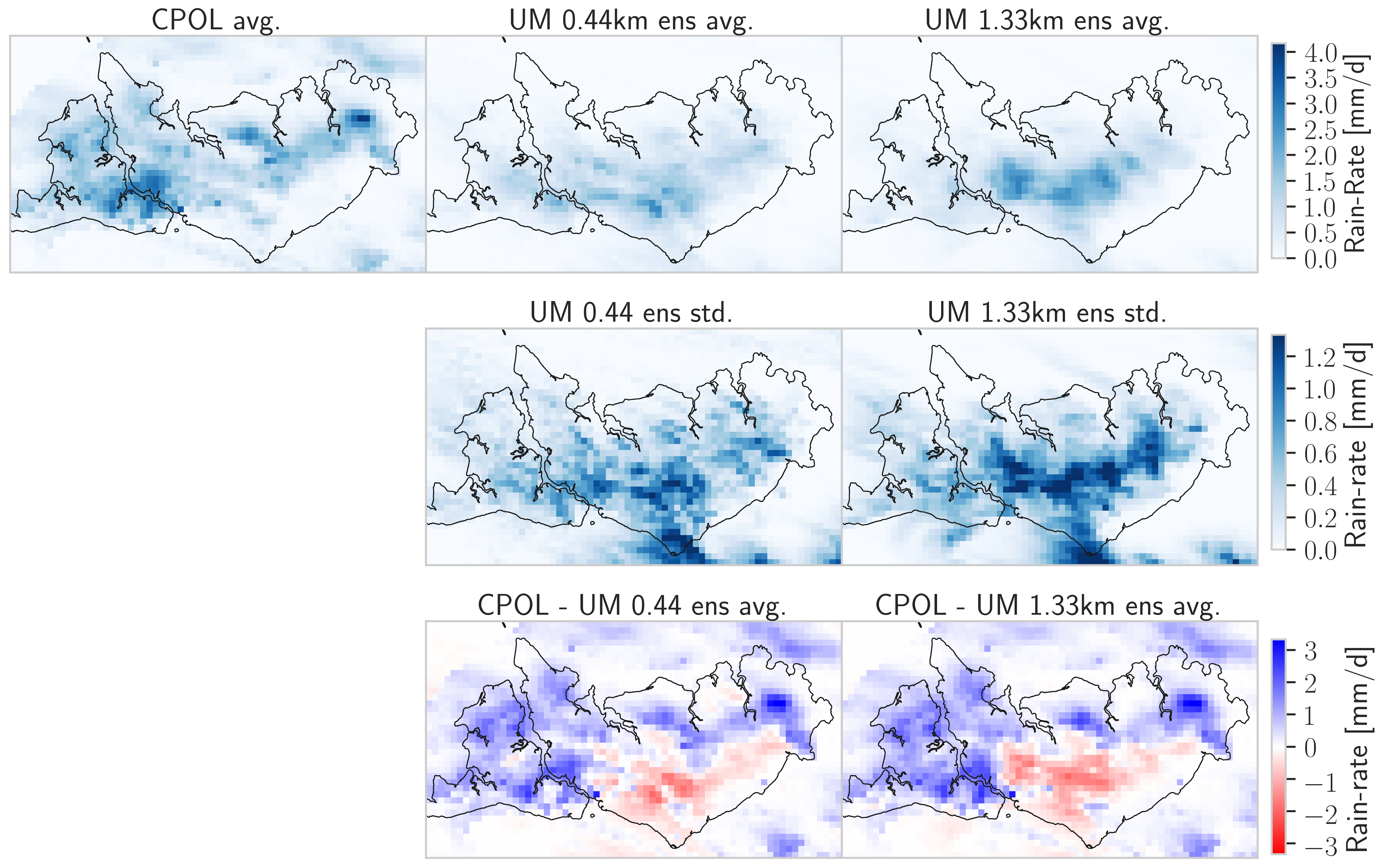
The simulated Diurnal Cycle¶
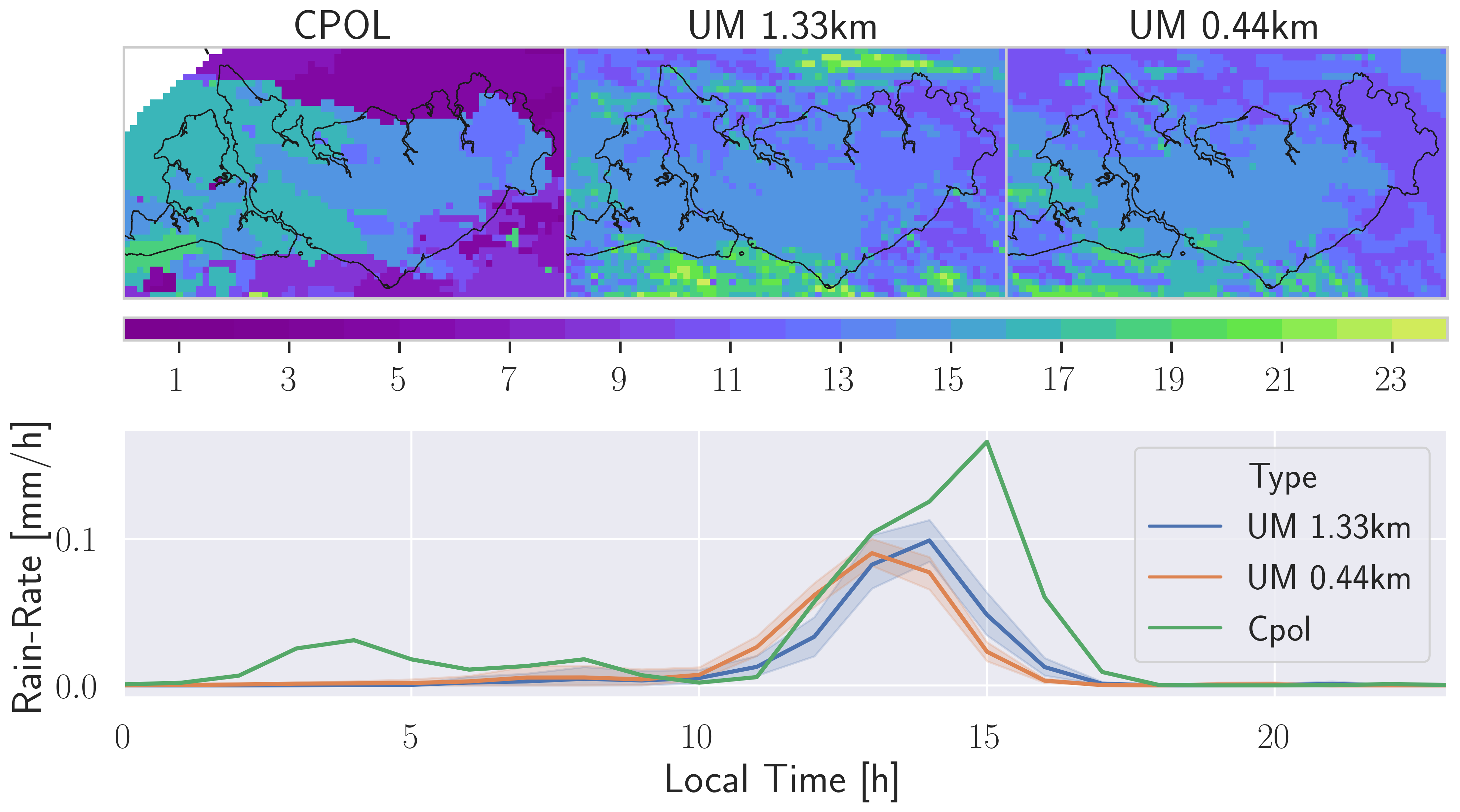
How well are Extremes Represented?¶
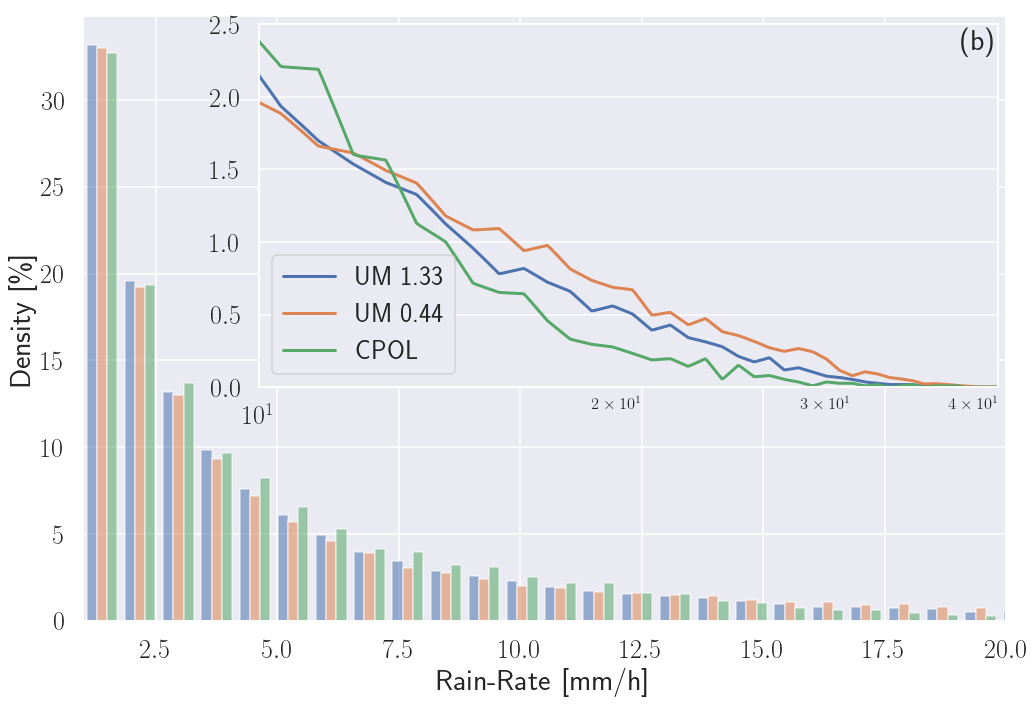
In Summary:¶
- Storms are a Little too early in the Model
- Occure too Central over Melville Island
- Extreme Events are Slighly Over Estimated
- Slight Improvement with Higher Resolution Version
Storm-Track Analysis¶
- Analyse Strom tracks using an adopted tracking verion of TINT
- TINT -> Tracking with Phase-Correlation and "Hungarian" similarity mathiching
In [15]:
display(pd.read_pickle('medians.pkl').round(2))
| UM 1.33km | UM 0.44km | CPOL | |
|---|---|---|---|
| Area | 76.67 | 61.25 | 110.68 |
| Duration | 60.00 | 50.00 | 60.00 |
| Avg-Rain | 4.78 | 5.65 | 4.52 |
| Max-Rain | 6.90 | 8.56 | 6.79 |
| Speed | 10.03 | 12.71 | 12.67 |
| # Storms | 73.00 | 50.00 | 42.00 |
The strongest Stormes (>9th decile)¶
In [16]:
f = open('../slides/d3plot_map.dmp','rb')
mapplot = pickle.load(f)
f.close()
display(mapplot)
Storm Properties by Intensity¶

Why are Storms more intense in the Sub-km version?¶
- Investigation of Cold-Pools
In [19]:
%%HTML
<figure>
<video width="500" loop="true" controls>
<source src='ColdPool-Ens-1.mp4' type="video/mp4">
</video>
<figcaption style="text-align: right">Tracking with Density Potential Temperature Field Pertubation</figcaption>
</figure>
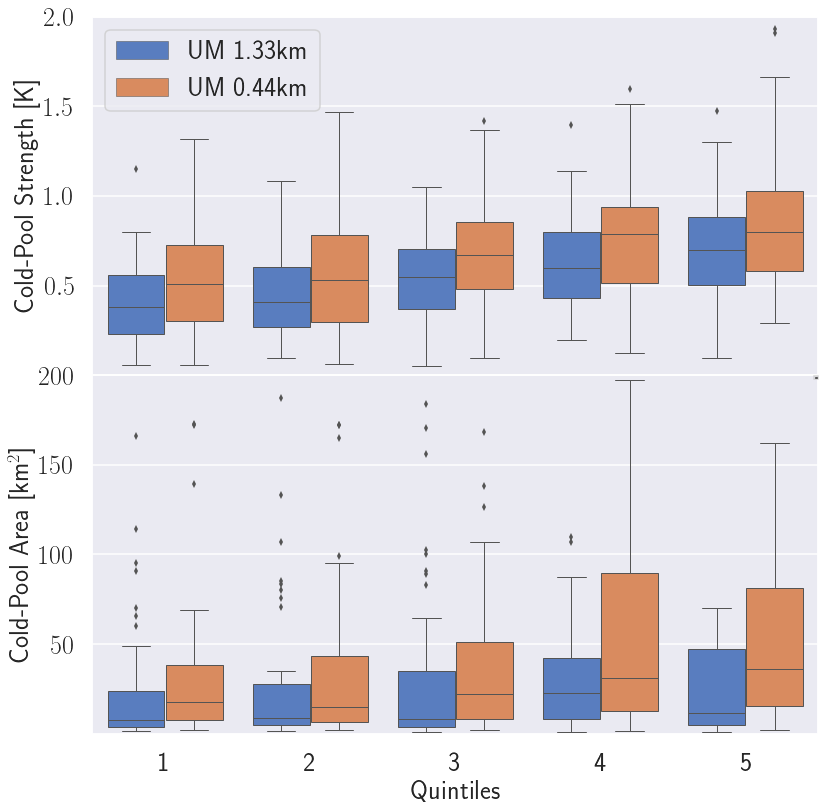
- The State of the Atmosphere
In [22]:
from copy import deepcopy
variables=dict(omega=(("$\\overline{\\omega'}$ [m/s]"), (-9.5e-2, 8.5e-1), 1),
mflux=("$\\overline{\\omega' q'}$ [m g/kg s]", (-1.2e-1, 1.6), 1000))#
nrow = 0
data = []
fontsize = 18
y_axis_layout=dict( gridcolor='rgb(255,255,255)', showgrid=True, showline=False, showticklabels=True,
titlefont=dict(size=fontsize), tickcolor='rgb(127,127,127)', ticks='outside',
zeroline=False, range=[P[0], P[-1]])
x_axis_layout=dict( gridcolor='rgb(255,255,255)', showgrid=True, showline=False, showticklabels=True,
tickcolor='rgb(127,127,127)', ticks='outside', zeroline=False, titlefont=dict(size=fontsize))
for layout_dict in (x_axis_layout, y_axis_layout):
layout_dict['tickfont']=dict(size=fontsize-2)
layout_dict['automargin'] = True
xaxis = {}
yaxis = {}
nplot = 1
nquint = 5
hspace, vspace = 0.01, 0.15
titles = []
colors = ('#1f77b4', '#ff7f0e')
for nvar, (var, prop) in enumerate(variables.items()):
nrow += 1
varn, xrange, mul = prop
for nn, quint in enumerate(range(1,nquint+1)):
for nrun, (run, flx) in enumerate(fluxes.items()):
x = flx[var][quint] * mul
if nrow == 1 :
yname = 'y'
else:
yname = 'y%i'%(nrow*nquint-nquint+1)
if nplot > 1:
showlegend=False
else:
showlegend=True
trace = go.Scatter(
x = x,
y = P,
name=run,
xaxis='x%i'%(nplot),
yaxis= yname,
visible = True,
showlegend = showlegend,
mode = 'lines',
line = dict(color = colors[nrun], width = 3)
)
data.append(trace)
yaxis['yaxis%i'%(nplot)] = deepcopy(y_axis_layout)
xaxis['xaxis%i'%(nplot)] = deepcopy(x_axis_layout)
xaxis['xaxis%i'%(nplot)]['title'] = varn
yaxis['yaxis%i'%(nplot)]['domain'] = split(len(variables), vspace)[nrow-1]
xaxis['xaxis%i'%(nplot)]['domain'] = split(nquint, hspace)[nn]
xaxis['xaxis%i'%(nplot)]['anchor'] = yname
yaxis['yaxis%i'%(nplot)]['anchor'] = 'x%i'%nplot
xaxis['xaxis%i'%(nplot)]['range'] = xrange
if quint == 1:
yaxis['yaxis%i'%(nplot)]['title']='Pressure [hPa]'
if nrow == 1:
xaxis['xaxis%i'%(nplot)]['range'] = xrange
sp = split(nquint, hspace)[nn]
titles.append(dict(x=(xrange[1]-xrange[0])/2 - ((xrange[1]-xrange[0])/20),
y=split(nquint, vspace)[-1][-1]+vspace/4,
showarrow=False,
text='Quintile %i'%quint,
xref='x%i'%(nplot),
yref='paper'))
nplot += 1
layout = go.Layout(
width=750,
height=800,
annotations=titles,
autosize=False,
paper_bgcolor='rgb(255,255,255)',
plot_bgcolor='rgb(229,229,229)',
font=dict(family='serif', size=fontsize, color='#7f7f7f')
)
for axis, axlayout in yaxis.items():
layout[axis] = axlayout
for axis, axlayout in xaxis.items():
layout[axis] = axlayout
'''
steps=[]
labels={i: str(i) for i in range(1,6)}
labels[0] = 'All'
for n in range(6):
step = dict(
method = 'restyle',
args = ['visible', [False] * len(data)],
label=labels[n])
for ii in range(2):
step['args'][1][n+ii*6] = True # Toggle i'th trace to "visible"
steps.append(step)
sliders = [dict(
active = 5,
currentvalue = {"prefix": "Quintile: "},
pad = {"t": 75},
steps = steps,
font=dict(size=16)
)]
layout['sliders'] = sliders
'''
fig = go.Figure(data=data, layout=layout)
display(py.iplot(fig, show_link=False))
In [28]:
%%HTML
<figure>
<video width="750" height="350" loop="true" controls>
<source src='ColdPool_nativ_2.mp4' type="video/mp4">
</video>
<figcaption style="text-align: right">Cold-Pool (center) and Rainfall (outer) for two ensemble member</figcaption>
</figure>
<img src="Diagram1.png" alt="Study area" style="height:150px;"/>
<p>One possible problem: Micro-Phys. depends on RH<sub>crit</sub> that is chosen on 80!! levels</p>

One possible problem: Micro-Phys. depends on RHcrit that is chosen on 80!! levels
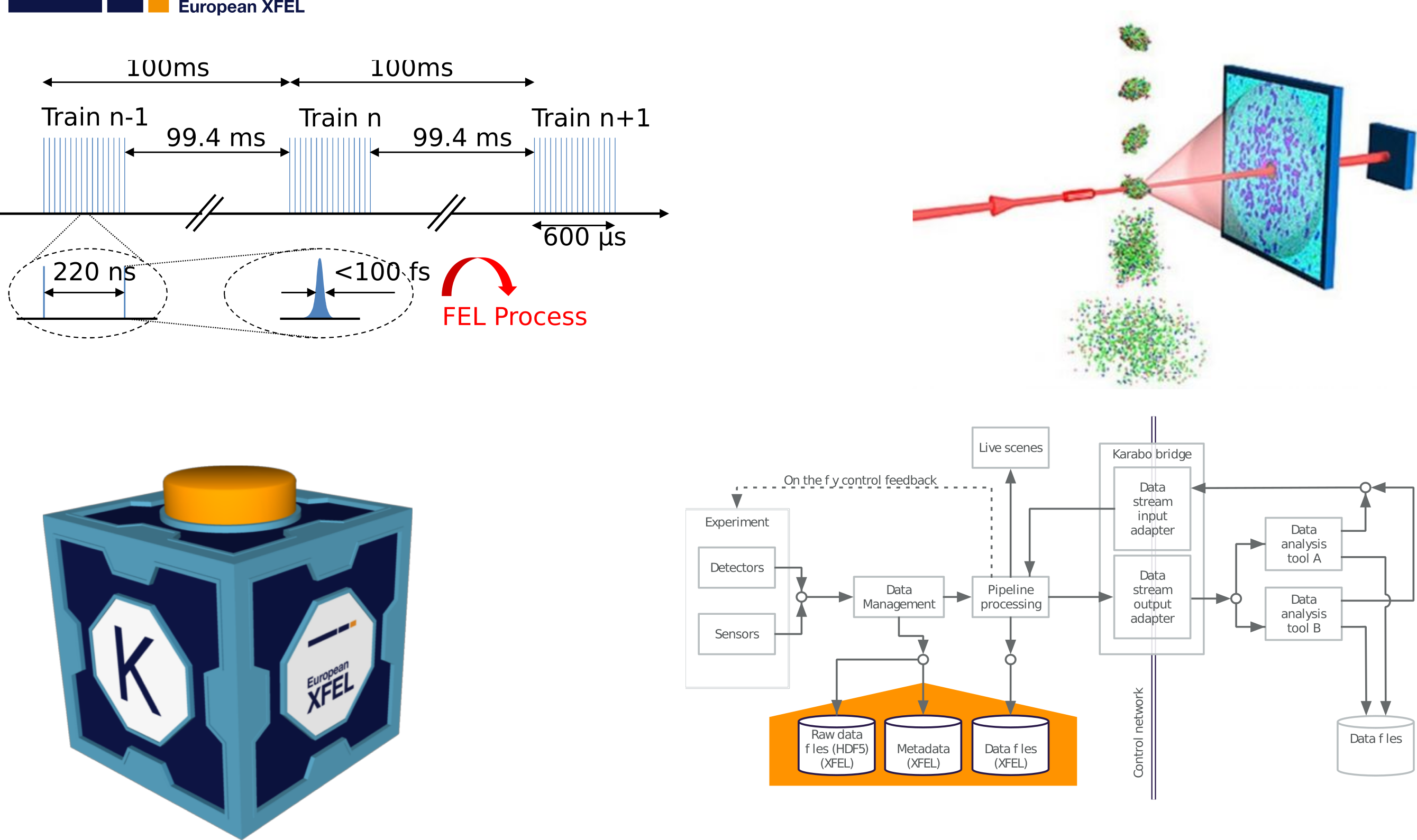
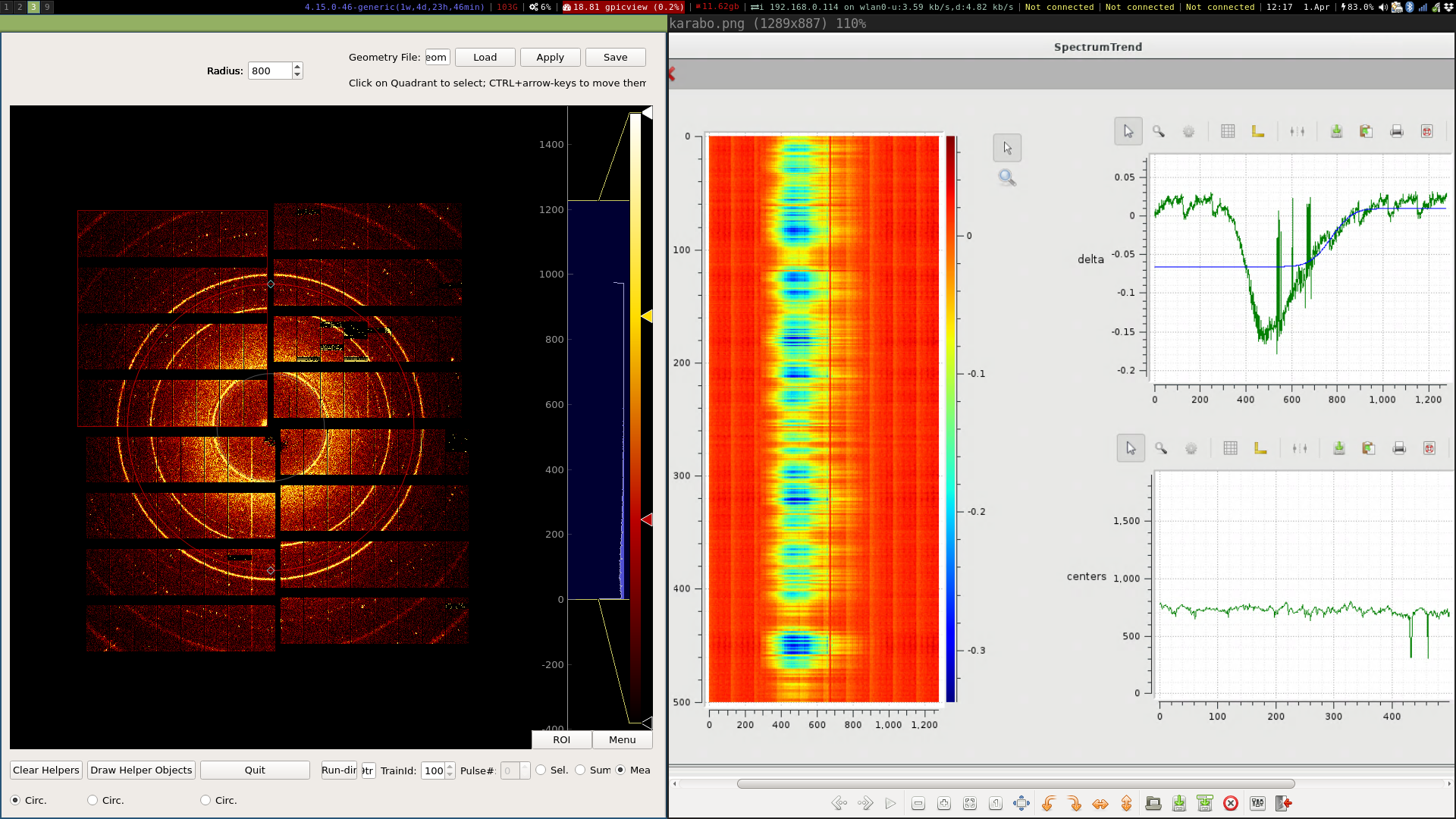
In [ ]: